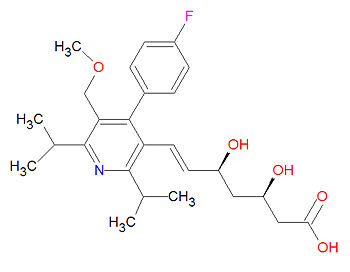Cerivastatin: Difference between revisions
Jump to navigation
Jump to search

imported>David E. Volk (New page: {{subpages}} [[Image:Cerivastatin structure.jpg|right|thumb|350px|{{#ifexist:Template:Cerivastatin structure.jpg/credit|{{Cerivastatin structure.jpg/credit}}<br/>|}}Cerivastatin, a type II...) |
imported>David E. Volk mNo edit summary |
||
| Line 4: | Line 4: | ||
'''Cerivastatin''', sold as '''Lipobay''', '''Rivastatin''' and '''Baycol''', ''now withdrawn from the U.S. and Canadian markets'', is a type II statin formerly used to treat high cholesterol levels ([[hypercholesterolemia]]), prevent [[myocardial infarction|heart attacks]] and [[stroke]]s, and to diminish the formation of [[atherosclerosis|arterial plaque]]. Baycol was voluntarily removed from the U.S. market in August of 2001 by Bayer Pharmaceutical Division due to reports of fatal [[rhabdomyolysis]]. | '''Cerivastatin''', sold as '''Lipobay''', '''Rivastatin''' and '''Baycol''', ''now withdrawn from the U.S. and Canadian markets'', is a type II statin formerly used to treat high cholesterol levels ([[hypercholesterolemia]]), prevent [[myocardial infarction|heart attacks]] and [[stroke]]s, and to diminish the formation of [[atherosclerosis|arterial plaque]]. Baycol was voluntarily removed from the U.S. market in August of 2001 by Bayer Pharmaceutical Division due to reports of fatal [[rhabdomyolysis]]. | ||
It is a [[Hydroxymethylglutaryl-coenzyme A reductase inhibitor|HMG-CoA reductase inhibitor]] which diminishes the conversion of HMG-CoA to [[mevalonate]], a key chemical precursor of [[cholesterol]]. | It is a [[Hydroxymethylglutaryl-coenzyme A reductase inhibitor|HMG-CoA reductase inhibitor]] which diminishes the conversion of HMG-CoA to [[mevalonate]], a key chemical precursor of [[cholesterol]]. | ||
It is structurally related to the other [[type II statin]]s, [[fluvastatin]], [[atorvastatin]] and [[rosuvastatin]]. | It is structurally related to the other [[type II statin]]s, [[fluvastatin]], [[atorvastatin]] (Lipitor) and [[rosuvastatin]] (Crestor). | ||
Revision as of 12:27, 24 January 2008
Cerivastatin, sold as Lipobay, Rivastatin and Baycol, now withdrawn from the U.S. and Canadian markets, is a type II statin formerly used to treat high cholesterol levels (hypercholesterolemia), prevent heart attacks and strokes, and to diminish the formation of arterial plaque. Baycol was voluntarily removed from the U.S. market in August of 2001 by Bayer Pharmaceutical Division due to reports of fatal rhabdomyolysis. It is a HMG-CoA reductase inhibitor which diminishes the conversion of HMG-CoA to mevalonate, a key chemical precursor of cholesterol. It is structurally related to the other type II statins, fluvastatin, atorvastatin (Lipitor) and rosuvastatin (Crestor).
brand names
- Baycol (withdrawn from US and Canadian markets)
- Lipobay
- Rivastatin
Drug interactions
- Bezafibrate increases the risk of myopathy/rhabdomyolysis
- Bosentan could decrease the statin effect
- Clarithromycin, a macrolide, possibly increases the statin toxicity
- Colchicine increases the risk of rhabdomyolysis
- Cyclosporine may cause myopathy and rhabdomyolysis
- Diltiazem increases the effect and toxicity of the statin
- Erythromycin a macrolide, possibly increases the statin toxicity
- Fenofibrate increases risk of myopathy/rhabdomyolysis
- Gemfibrozil increases risk of myopathy/rhabdomyolysis
- Imatinib increases the effect and toxicity of statin
- Itraconazole increases the risk of myopathy/rhabdomyolysis
- Josamycin, a macrolide, possibly increases the statin toxicity
- Ketoconazole increases the risk of myopathy/rhabdomyolysis
- Nefazodone increases the effect and toxicity of the statin drug
- Quinupristin presents an increased risk of toxicity
- Rifabutin, a rifamycin, decreases the effect of statin drug
- Rifampin, a rifamycin, decreases the effect of statin drug
